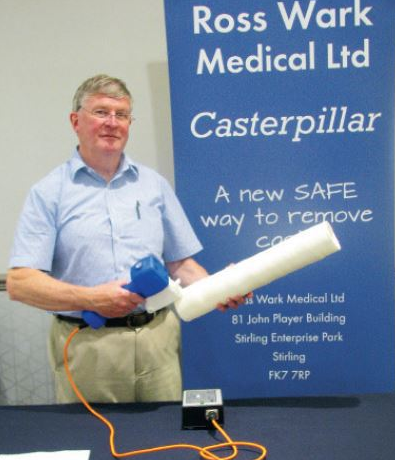Orthopaedic Product News Article June 2018 Breaking the mould in cast removal
Consultant orthopaedic surgeon David Ross encountered many problems when removing casts with oscillating cast saws, so he designed and developed the CasterpillarTM, a completely new device for cast removal, which would be quieter and safer for both the patient and the operator

The majority of upper and lower limb fractures are still treated by application of a cast. Plaster of Paris is often used for the initial cast and this is relatively easy to remove using plaster shears or scissors, cutting the padding of a simple back-slab. Lightweight synthetic casting materials have been developed for longer-term fracture immobilisation and are removed after the fracture has healed, usually after several weeks.
These synthetic casts have many advantages, they are lighter and stronger than Plaster of Paris and have good wear and water resistance. Due to the strength of synthetic casts they currently have to be removed using a high-speed oscillating saw. The problems associated with oscillating cast saws are well documented; they are noisy and can be terrifying, particularly for young children. The noise prevents good communication between the clinician and the patient and can be so loud that it affects other patients in adjacent rooms or cubicles.
Small quadrant shaped saw blades fitted to small saws designed for paediatric use can also become hot very quickly; larger circular blades on standard saws allow more heat diffusion and can be rotated to bring a relatively cooler area into use. Linear skin burns caused by a hot saw blade, most likely to occur when the saw is used by an inexperienced operator, are not common but distressing and probably medico-legally indefensible. A child can become very distressed when having a cast removed and it may not be possible for the clinician to distinguish between the anxiety caused by the appearance and noise of the saw, and actual pain.
The hands of the person operating the high speed oscillating saw are likely to be exposed to a significant level of vibration. Vibration exposure has been linked to hand arm vibration syndrome (HAVS or vibration white finger) and carpal tunnel syndrome. The dust produced by the saw has to be collected by a large and noisy vacuum extractor as this dust may be harmful if inhaled. All of these problems are well recorded in the medical scientific literature.
While working as an orthopaedic surgeon in Stirling, I contacted Scottish Enterprise who introduced me to George Miller, an electronics engineer. We formed Ross Wark Medical Ltd, to design and develop a completely new device for cast removal, which would be quieter and safer for both the patient and the operator. “Smart Prototyping” techniques, including the use of CAD-CAM (computer aided design and manufacture) and 3D printing were employed, and in 2014 CasterpillarTM was launched.
This cast cutter was a major innovation: a powered shear rather than a saw. Casterpillar is quiet, produces little vibration and virtually no dust. It simultaneously cuts through the synthetic cast material, the stockinet and under-cast padding and is therefore probably quicker at removing a cast than a cast saw. Casterpillar is quiet and does not look like a circular saw, so is unlikely to produce an anxiety reaction in patients. Casterpillar is likely to be more economical than a cast saw as regular replacement of blades, vacuum filters and tubing will not be required. Since 2015 a number of the first version of Casterpillar have been in use in hospitals in Scotland and England, with very positive feedback.
Since retiring from clinical practice, I have been able to concentrate on the further development of Casterpillar, which now has UK, US, Canadian and German patents. With help from Business Gateway we were able to apply successfully for funding from Scottish Enterprise to improve the Casterpillar Cast Cutter. Electronic technological advances allowed the use of a smaller, lighter, but more powerful motor and we were able to simplify the control switches and low voltage power supply unit.
A second generation Casterpillar Cast Cutter has been developed which is lighter, easier to use and has a better cutting performance.
We do not anticipate that Casterpillar will be able to replace every cast saw; cast saws will still be required for very thick casts, such as a long-leg cast for a large adult. However, we hope that most patients, particularly children and the frail elderly, will benefit from having casts removed quietly and safely by a Casterpillar.
The full article can be down loaded by clicking on the link below....
Site Navigation
Ross Wark Medical Ltd
23 Marchbank Gardens
Balerno
Midlothian
EH14 7ET
Tel +44(0)131 449 5674
E Mail info@rosswark.com